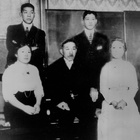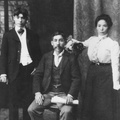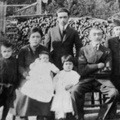If Nagano did not arrive in 1877, who might have been the first immigrant from Japan to put down roots and leave his bones in Canada? Sumio Ishidate quoted above, had written in 1909 that “in 1884 several Japanese landed at Victoria . . . among them Kisuke Mikuni and Tomekichi Homma.”
Most documents circulating today mention Homma as arriving in 1883 in Steveston, where he later joined other Japanese to fish for salmon. Nobody has made the claim he was the first Japanese to arrive, because it has been generally accepted that Nagano had come in 1877. Now, with no evidence to support Nagano’s claim, Homma moves into the running.
Chronology of Tomekichi Homma’s Life
Below is a chronology of Homma’s life that has appeared in a number of published documents. (The claims in italics have not been substantiated after detailed search of historic records.)
| 1865 |
Born on June 6, in Ichikawa, Chiba, Japan |
| 1883 | Age 18, arrived in Canada and settled in Steveston, British Columbia |
| 1887 | Helped to establish the first Japanese Fishermen’s Association in Steveston, and became its first president. |
| 1887-99 | Held the position of president of the Fishermen’s Association, helped to establish the Fishermen’s Hospital and the first Japanese language school in Steveston. |
| 1896 | He became a naturalized Canadian citizen. |
| 1897 | Married Matsu Tanikawa of Fukuoka, Japan, moved to Vancouver, helped to publish the first Japanese language newspaper, Canada Shimpo, provided labourers for the CPR construction projects, opened a boarding house on Pender Street, founded a social club and served as chairman. |
| 1900-02 |
Legally challenged the provincial government’s law that denied Japanese Canadians the right to vote. In the first court review the judge supported Homma’s right to be on the Voters List. The province appealed the decision to the B.C. Supreme Court. The Supreme Court once more agreed that Homma had a right to vote in elections. Not satisfied, the provincial government appealed to the Privy Council in London (At the time the British Privy Council was the last court of appeal for Canadian legal cases). On December 17, 1902, the Privy Council in England reversed the B.C. court’s decisions. Consequently Homma was prevented from being able to vote—as were other Japanese Canadians. |
| 1909 | Moved to the Great Northern Fish Cannery in West Vancouver, working as a night watchman. He lived in one of the small homes built for fishermen, until interned during the Pacific War. |
| 1915-22 | Conducted interviews for Jinshiro Nakayama for the publication of Kanada Doho Hatten Taikan (Encyclopedia of Japanese in Canada). |
| 1929 | A fire burned down Homma’s house in the Cannery, destroying all his diaries and records that he had maintained over the years. Sometime during the next few years he suffered a stroke and slowly lost control of his speech and some mobility. |
| 1942 | Interned to Popoff Internment Settlement in B.C.’s interior near Slocan. |
| 1945 | Homma died on Oct. 28, at age 80, buried at Mountain View Cemetery in Vancouver, B.C. His wife lived on until 1951. |
The chronology can be considered relatively reliable from 1897 on, with three exceptions: Canada Shimpo was not published until 1907, at that time under the editorship of Rev. Kaburagi. Second, the Japanese language school in Steveston was not operating until 1906, well after Homma moved to Vancouver. Third, The Japanese Fishermen’s Hospital was not erected until 1900.1 That was the year the newly formed Gyosha Dantai (Japanese Fishermen’s Benevolent Society) agreed to assume responsibility for the hospital. Homma had moved to Vancouver earlier.

First, the chronology above states Homma was naturalized in 1896. The correct date was 1893. Proof is found in the documents sent by the Attorney- General of B.C. to the Privy Council in London on appeal regarding the right to vote.
On page 2, numbered paragraph 2, the following statement appears:
The Respondent is a native of the Japanese Empire, not born of British parents. Having settled as an alien in British Columbia, he on the 4th April, 1893, duly obtained a certificate of naturalization in Form “C” in the Schedule to the Naturalization Act (R. S. Can., cap. 113).2 [In the documents Homma is referred to as “Tomey” Homma, rather than his full Japanese name.]
Before examining other major mistaken claims, it is worth looking at his two most important contributions. He will always be remembered for his legal fight to secure the franchise for naturalized Japanese Canadians. Next, would be his assistance with the work of Jinshiro Nakayama in compiling the history of early Japanese arrivals to Canada, Kanada Doho Hatten Taikan, published in Vancouver, 1922.
It is important to note that none of the misinformation as to dates or activities attributed to Homma was ever claimed by him to be true. No examples have been found where he misrepresented himself. However, there remain a number of contradictions in the general literature (as well as in the chronology above) to what others have claimed about his early years. Below are four examples of published material containing misinformation.
-
The New Canadian, Jan. 1, 1992 in a story about the opening of a new school named Tomekichi Homma Elementary School in Steveston:
Tomekichi Homma was born in Japan’s Chiba-kem June 6, 1865 . . . At the age of 18, [1883] he emigrated to Canada . . . “Mr. Homma was one of the first Japanese to settle in Steveston and was instrumental in organizing other fishermen expatriates into an association in 1887, serving as its first chairman until 1899.” -
The Richmond Review, Jan. 10. 2009, headlined “Homma fought back against racism”:
[Homma] arrived in Canada in 1883. Established first Japanese Fishermen’s Association in Steveston in 1887 and served as president from 1887 to 1899. -
Vancouver Shimpo, Jan 1, 1998, featured a major article in Japanese based on a book in Japanese by Shigeharu Koyame, The Life of Tomokichi Homma. The article was translated into English by W. Hashizume, appearing in the Nikkei Voice, Feb. 2000:
Homma was born in June of 1865 in Onigoshi-mura (now Ichikawa Machi), to a samurai family that had served the Lord Kuroda family for generations. In 1882 at age 18, Homma sailed for Canada and was engaged in salmon fishing in Steveston.” (There are conflicting views as to when he came to Canada—some say 1883, others 1887.) -
Nikkei Legacy, by Toyo Takata, published in 1983 on p. 63; Takata describes Tomekichi (Tomey) Homma:
He was not a passing migrant clutching at quick riches. A scion of proud lineage, Homma was a born leader and devoted activist. As a pioneer who landed in Canada in 1887, he and his cohorts founded Steveston’s Gyosha Dantai [Fishermen’s Benevolent Association] and he was selected to be its first chairman. Besides, he was prominent in creating the earliest Japanese language school, and was a factor in the first Japanese daily in Vancouver, Canada Shimpo. His English was such that he was called upon to assist in the courts.
Two additional statements need to be clarified. The first is the claim that Homma became the president of the Japanese Fishermen’s Association in 1887. The Spirit of the Nikkei Fleet, produced by the Nikkei Fishermen’s Book Committee in 2009, gives a detailed history of the three early Fishermen’s Associations.3 The first, Ryoshi Dantai or the (Japanese Fraser River Fishermen’s Association), was created in 1897. The records of the Association clearly state that Tomekichi Homma was the president from its formation in 1897 to 1899.
There was no Ryoshi Dantai or Gyosha Dantai in 1887. In fact, there is little evidence that any Japanese lived in the area. Toyo Takata wrote about Gihei Kuno visiting Steveston for the first time in 1887, when he famously saw teeming salmon moving up the Fraser River in such numbers a person could almost walk over them. Realizing the potential of the Fraser River salmon, Kuno wrote back to his village in Wakayama encouraging people to come to Steveston. The result was a heavy migration from Wakayama over the next few years. Within a short time, over half the population of Steveston was made up of people from Wakayama.
Notes:
1. Daphne Marlatt, Steveston Recollected: A Japanese-Canadian History, Victoria, B.C., 1975. pp. 35-37. (Earlier in 1898, the Japanese Christian Church located on the cannery, opened a small clinicsupported by Minister Matsutaro Okamoto and Ukichi Oyama to deal with the typhoid epidemic).
2. Appeal to the Privy Council, from the Supreme Court of British Columbia, (in regard to voting rights), Nikkei National Museum, Burnaby, B.C., Homma Family Collection, Supreme Court transcript.
3. Masako Fukawa, Stanley Fukawa and the Nikkei Fishermen’s History Book Committee, Spirit of theNikkei Fleet: BC’s Japanese Canadian Fishermen, Madeira Park, B.C., 2009. pp. 73-97.
*This article was originally published in the Nikkei Images, A publication of the Nikkei National Museum & Cultural Centre (Volume 28, No. 1).
© 2023 Ann-Lee Switzer, Gordon Switzer








